An Improved STARFM with Help of an Unmixing-Based Method to Generate High Spatial and Temporal Resolution Remote Sensing Data in Complex Heterogeneous Regions
Abstract
:1. Introduction
2. Description of USTARFM
2.1. Land Cover Cluster and Abundance Extraction
2.2. Unmixing Data
2.3. Fused Image Generation
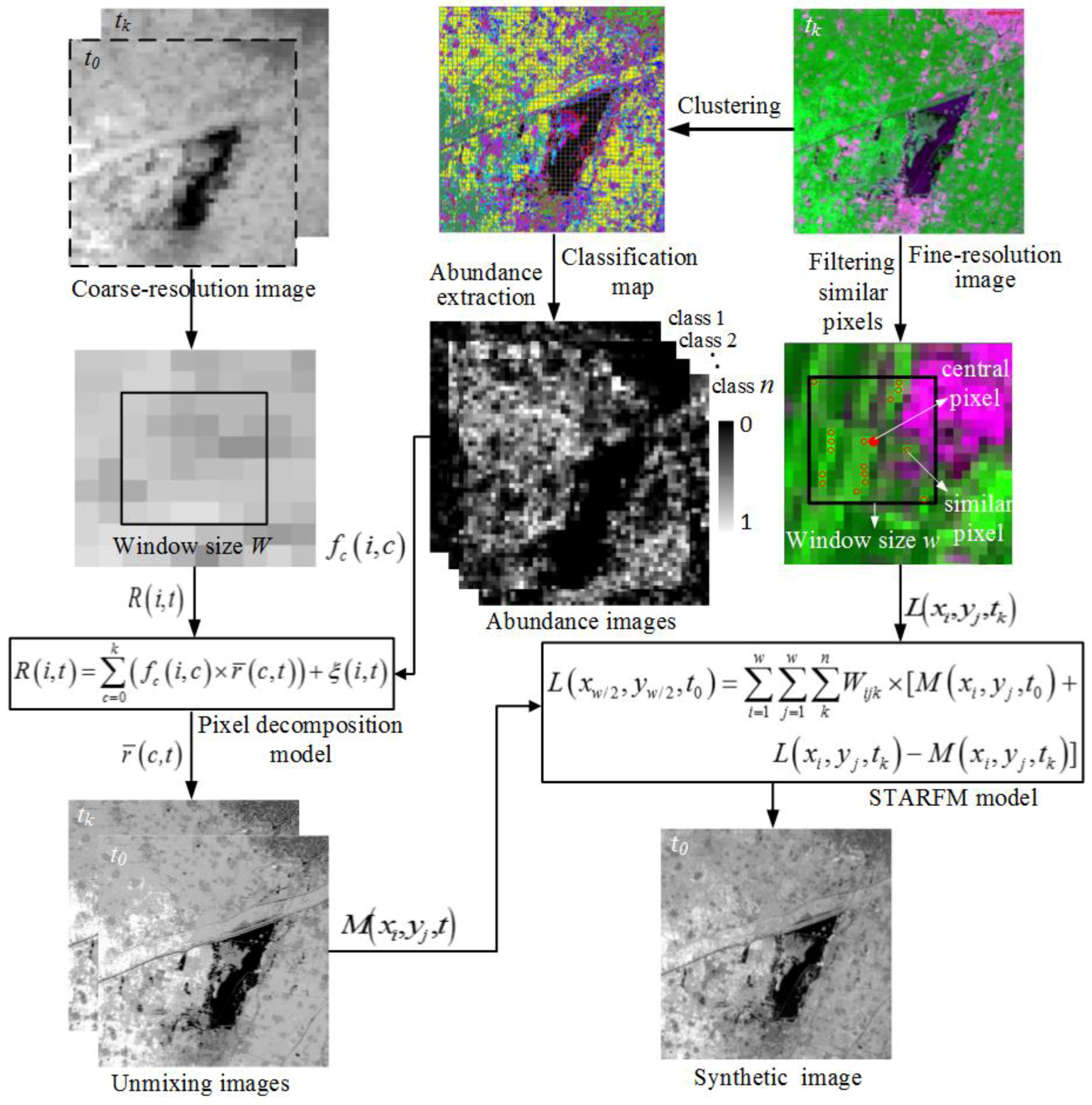
3. Algorithm Test
3.1. Test Data and Preprocessing
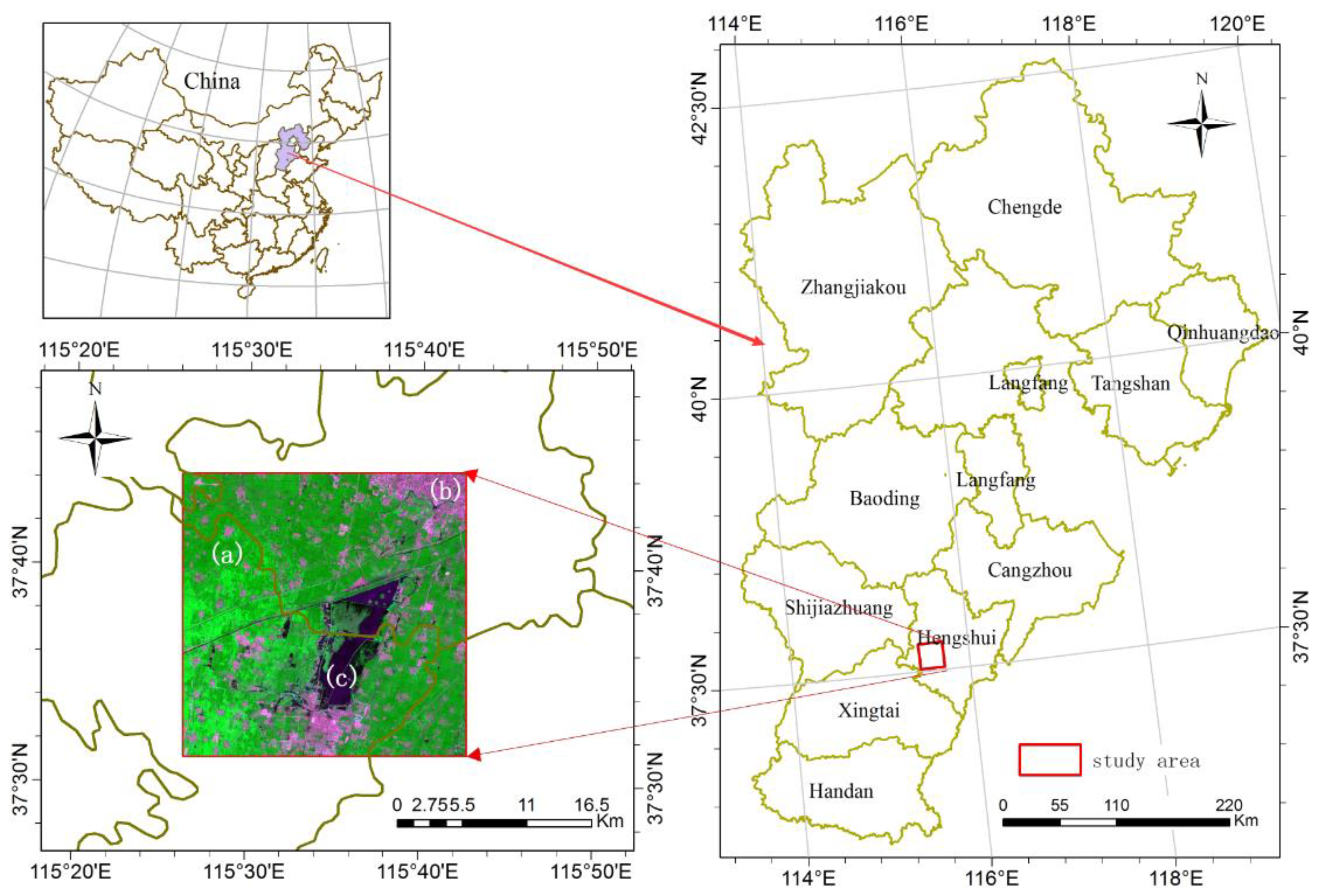
| Data | Acquisition Date | (Path/Row) | Data Usage |
|---|---|---|---|
| Landsat 8 (OLI) | 8/19/2014 | 123/034 | Classification and similar pixels selection () |
| 9/4/2014 | Accuracy assessment () | ||
| MOD09GA | 8/19/2014 | h27/v05 | Unmixing data acquisition |
| 9/4/2014 |
3.2. Implementation Procedure
4. Results and Discussion
4.1. Algorithm Performance Analysis Influenced by W, k and w
| Date | W | k | γ | RMSE | ERGAS | ||||||
|---|---|---|---|---|---|---|---|---|---|---|---|
| Green | Red | NIR | Green | Red | NIR | Green | Red | NIR | |||
| 8/19/2014 | 7 | 5 | 0.69 | 0.74 | 0.92 | 0.0204 | 0.0233 | 0.0378 | 2.0467 | 2.6494 | 0.7457 |
| 10 | 0.64 | 0.70 | 0.86 | 0.0218 | 0.0254 | 0.0511 | 2.1818 | 2.8778 | 1.0087 | ||
| 15 | 0.49 | 0.55 | 0.76 | 0.0280 | 0.0339 | 0.0719 | 2.7995 | 3.8519 | 1.4185 | ||
| 20 | 0.49 | 0.55 | 0.70 | 0.0274 | 0.0343 | 0.0850 | 2.7452 | 3.8968 | 1.6775 | ||
| 25 | 0.33 | 0.41 | 0.44 | 0.0393 | 0.0469 | 0.1682 | 3.9298 | 5.3230 | 3.3205 | ||
| 30 | 0.27 | 0.36 | 0.37 | 0.0455 | 0.0534 | 0.2117 | 4.5525 | 6.0575 | 4.1790 | ||
| 11 | 5 | 0.75 | 0.80 | 0.94 | 0.0192 | 0.0212 | 0.0334 | 1.9256 | 2.4074 | 0.6586 | |
| 10 | 0.78 | 0.82 | 0.90 | 0.0186 | 0.0205 | 0.0436 | 1.8594 | 2.3230 | 0.8598 | ||
| 15 | 0.66 | 0.70 | 0.88 | 0.0216 | 0.0255 | 0.0480 | 2.1587 | 2.8978 | 0.9484 | ||
| 20 | 0.57 | 0.61 | 0.74 | 0.0244 | 0.0301 | 0.0779 | 2.4440 | 3.4197 | 1.5382 | ||
| 25 | 0.49 | 0.55 | 0.47 | 0.0283 | 0.0345 | 0.1586 | 2.8297 | 3.9100 | 3.1305 | ||
| 30 | 0.44 | 0.50 | 0.41 | 0.0308 | 0.0382 | 0.1950 | 3.0807 | 4.3364 | 3.8494 | ||
| 15 | 5 | 0.76 | 0.81 | 0.95 | 0.0191 | 0.0210 | 0.0321 | 1.9126 | 2.3859 | 0.6342 | |
| 10 | 0.82 | 0.86 | 0.92 | 0.0179 | 0.0189 | 0.0399 | 1.7908 | 2.1473 | 0.7884 | ||
| 15 | 0.74 | 0.78 | 0.92 | 0.0195 | 0.0218 | 0.0395 | 1.9489 | 2.4708 | 0.7790 | ||
| 20 | 0.68 | 0.73 | 0.75 | 0.0208 | 0.0242 | 0.0755 | 2.0831 | 2.7472 | 1.4906 | ||
| 25 | 0.61 | 0.67 | 0.47 | 0.0230 | 0.0274 | 0.1596 | 2.3025 | 3.1142 | 3.1503 | ||
| 30 | 0.56 | 0.61 | 0.40 | 0.0250 | 0.0309 | 0.1980 | 2.5007 | 3.5034 | 3.9086 | ||
| 21 | 5 | 0.77 | 0.81 | 0.95 | 0.0190 | 0.0210 | 0.0313 | 1.9047 | 2.3805 | 0.6171 | |
| 10 | 0.85 | 0.88 | 0.92 | 0.0174 | 0.0179 | 0.0387 | 1.7426 | 2.0301 | 0.7636 | ||
| 15 | 0.80 | 0.85 | 0.94 | 0.0181 | 0.0189 | 0.0338 | 1.8075 | 2.1443 | 0.6671 | ||
| 20 | 0.76 | 0.81 | 0.75 | 0.0189 | 0.0209 | 0.0762 | 1.8915 | 2.3697 | 1.5033 | ||
| 25 | 0.72 | 0.77 | 0.47 | 0.0199 | 0.0226 | 0.1734 | 1.9972 | 2.5679 | 3.4237 | ||
| 30 | 0.68 | 0.71 | 0.39 | 0.0211 | 0.0251 | 0.2074 | 2.1118 | 2.8530 | 4.0942 | ||
| 31 | 5 | 0.77 | 0.81 | 0.95 | 0.0190 | 0.0212 | 0.0297 | 1.9021 | 2.3749 | 0.5360 | |
| 10 | 0.86 | 0.90 | 0.92 | 0.0171 | 0.0173 | 0.0391 | 1.7107 | 1.9402 | 0.7714 | ||
| 15 | 0.81 | 0.87 | 0.95 | 0.0178 | 0.0180 | 0.0305 | 1.7796 | 2.0228 | 0.6023 | ||
| 20 | 0.83 | 0.88 | 0.70 | 0.0173 | 0.0177 | 0.0877 | 1.7368 | 1.9883 | 1.7310 | ||
| 25 | 0.78 | 0.84 | 0.43 | 0.0185 | 0.0194 | 0.1857 | 1.8486 | 2.1757 | 3.6662 | ||
| 30 | 0.78 | 0.82 | 0.37 | 0.0185 | 0.0202 | 0.2254 | 1.8540 | 2.2664 | 4.4490 | ||
| 41 | 5 | 0.75 | 0.80 | 0.95 | 0.0193 | 0.0214 | 0.0300 | 1.9360 | 2.4314 | 0.5446 | |
| 10 | 0.85 | 0.89 | 0.92 | 0.0173 | 0.0174 | 0.0387 | 1.7310 | 1.9755 | 0.7643 | ||
| 15 | 0.81 | 0.88 | 0.95 | 0.0178 | 0.0178 | 0.0401 | 1.7852 | 2.0206 | 0.5926 | ||
| 20 | 0.85 | 0.89 | 0.70 | 0.0173 | 0.0174 | 0.0911 | 1.7965 | 1.9787 | 1.7981 | ||
| 25 | 0.80 | 0.87 | 0.43 | 0.0180 | 0.0184 | 0.1956 | 1.8047 | 2.0834 | 3.8616 | ||
| 30 | 0.82 | 0.86 | 0.34 | 0.0176 | 0.0186 | 0.2704 | 1.7598 | 2.1079 | 5.3374 | ||
| 9/4/2014 | 31 | 10 | 0.82 | 0.86 | 0.90 | 0.0182 | 0.0222 | 0.0401 | 1.8052 | 2.3020 | 0.8737 |
| Method | Window Size w n × n OLI Pixels | γ | RMSE | ERGAS | ||||||
|---|---|---|---|---|---|---|---|---|---|---|
| Green | Red | NIR | Green | Red | NIR | Green | Red | NIR | ||
| STARFM | 7 | 0.8822 | 0.8926 | 0.9416 | 0.0130 | 0.0172 | 0.0373 | 1.2823 | 1.8061 | 0.8088 |
| 11 | 0.8880 | 0.8987 | 0.9394 | 0.0130 | 0.0172 | 0.0351 | 1.2865 | 1.8129 | 0.7611 | |
| 31 | 0.8895 | 0.9000 | 0.9489 | 0.0127 | 0.0170 | 0.0300 | 1.2559 | 1.7916 | 0.6507 | |
| 61 | 0.8844 | 0.8948 | 0.9490 | 0.0131 | 0.0176 | 0.0302 | 1.2968 | 1.8498 | 0.6553 | |
| 101 | 0.8804 | 0.8931 | 0.9474 | 0.0133 | 0.0177 | 0.0309 | 1.3117 | 1.8673 | 0.6702 | |
| 151 | 0.8792 | 0.8921 | 0.9475 | 0.0133 | 0.0179 | 0.0310 | 1.3147 | 1.8782 | 0.6735 | |
| USTARFM | 7 | 0.9116 | 0.9226 | 0.9600 | 0.0118 | 0.0151 | 0.0260 | 1.1678 | 1.5876 | 0.5654 |
| 11 | 0.9129 | 0.9229 | 0.9631 | 0.0116 | 0.0151 | 0.0249 | 1.1502 | 1.5850 | 0.5416 | |
| 31 | 0.9121 | 0.9192 | 0.9650 | 0.0117 | 0.0154 | 0.0245 | 1.1550 | 1.6224 | 0.5317 | |
| 61 | 0.9106 | 0.9171 | 0.9650 | 0.0117 | 0.0156 | 0.0245 | 1.1564 | 1.6437 | 0.5326 | |
| 101 | 0.9094 | 0.9158 | 0.9650 | 0.0117 | 0.0158 | 0.0246 | 1.1615 | 1.6572 | 0.5334 | |
| 151 | 0.9083 | 0.9145 | 0.9650 | 0.0118 | 0.0159 | 0.0246 | 1.1671 | 1.6700 | 0.5341 | |
4.2. Accuracy Assessment Under the Best Parameters Setting
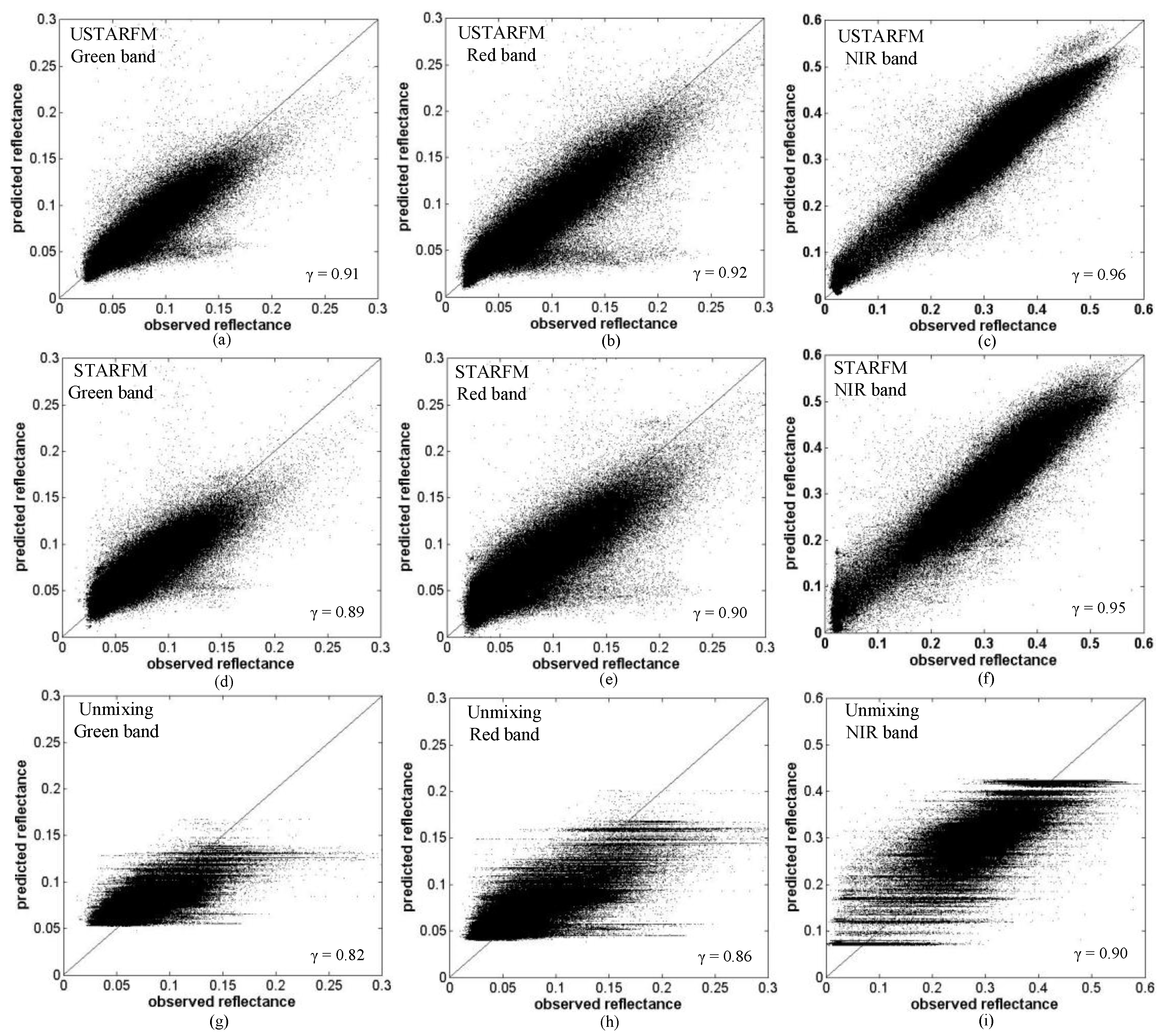
4.3. Landscape Heterogeneity Impact on USTARFM Performance
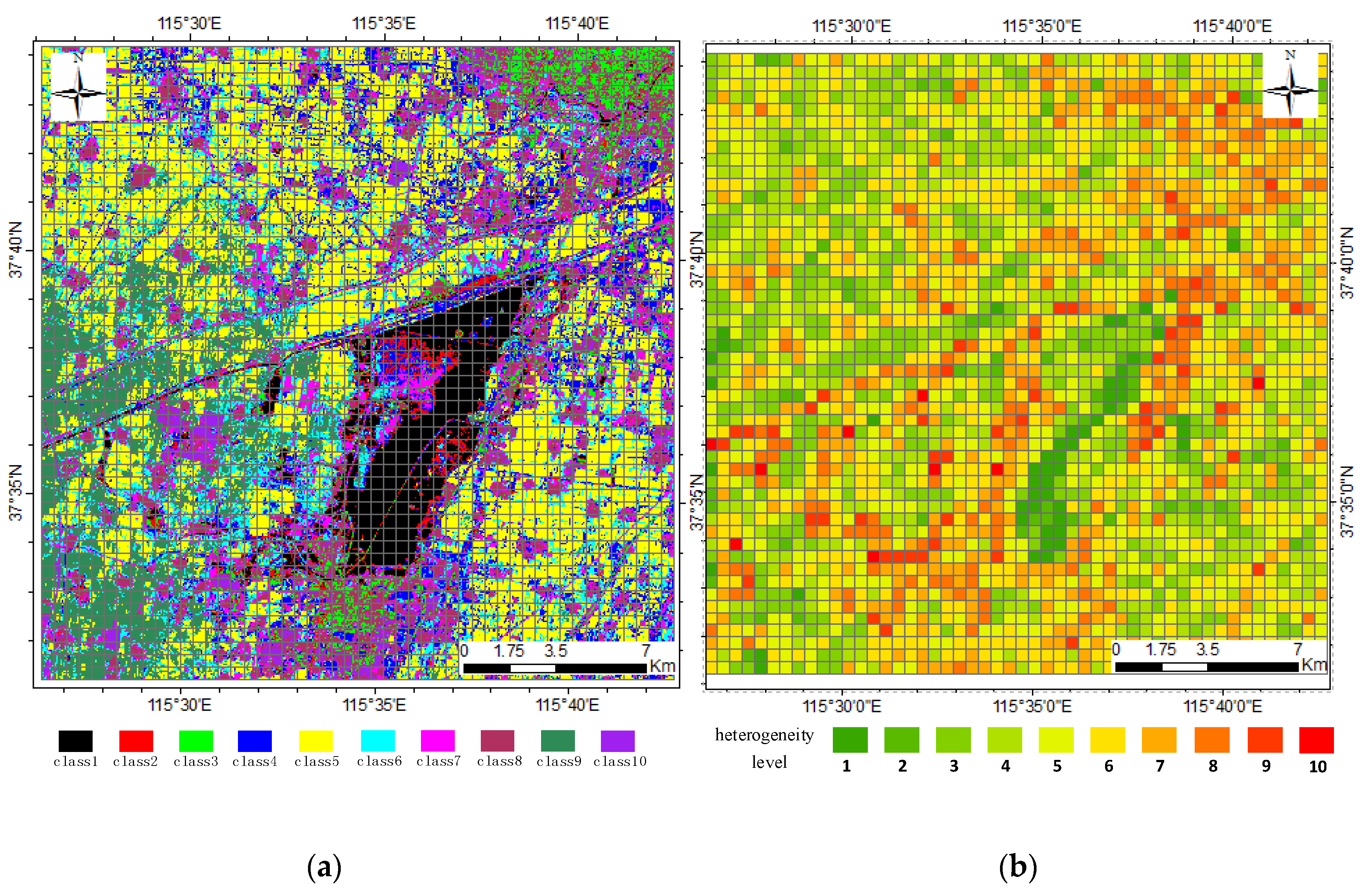

| h | Unmixing Data | Resampled Data | |||||
|---|---|---|---|---|---|---|---|
| Green | Red | NIR | Green | Red | NIR | ||
| γ | 1 | 0.77 | 0.83 | 0.99 | 0.89 | 0.90 | 0.98 |
| 2 | 0.75 | 0.80 | 0.98 | 0.72 | 0.75 | 0.96 | |
| 3 | 0.82 | 0.85 | 0.94 | 0.74 | 0.76 | 0.91 | |
| 4 | 0.81 | 0.84 | 0.88 | 0.67 | 0.69 | 0.80 | |
| 5 | 0.82 | 0.85 | 0.87 | 0.52 | 0.53 | 0.73 | |
| 6 | 0.80 | 0.84 | 0.81 | 0.43 | 0.42 | 0.58 | |
| 7 | 0.78 | 0.84 | 0.83 | 0.33 | 0.33 | 0.51 | |
| 8 | 0.78 | 0.83 | 0.82 | 0.26 | 0.25 | 0.36 | |
| 9 | 0.77 | 0.83 | 0.84 | 0.17 | 0.20 | 0.19 | |
| 10 | 0.81 | 0.84 | 0.86 | 0.11 | 0.11 | 0.11 | |
| RMSE | 1 | 0.0128 | 0.0142 | 0.0487 | 0.0102 | 0.0111 | 0.0492 |
| 2 | 0.0167 | 0.0165 | 0.0377 | 0.0158 | 0.0152 | 0.0448 | |
| 3 | 0.0177 | 0.0187 | 0.0355 | 0.0183 | 0.0200 | 0.0433 | |
| 4 | 0.0173 | 0.0187 | 0.0334 | 0.0198 | 0.0231 | 0.0412 | |
| 5 | 0.0180 | 0.0220 | 0.0384 | 0.0243 | 0.0327 | 0.0530 | |
| 6 | 0.0194 | 0.0247 | 0.0412 | 0.0271 | 0.0380 | 0.0574 | |
| 7 | 0.0200 | 0.0256 | 0.0456 | 0.0287 | 0.0409 | 0.0711 | |
| 8 | 0.0196 | 0.0247 | 0.0484 | 0.0287 | 0.0407 | 0.0803 | |
| 9 | 0.0184 | 0.0232 | 0.0517 | 0.0270 | 0.0387 | 0.0969 | |
| 10 | 0.0207 | 0.0283 | 0.0580 | 0.0343 | 0.0505 | 0.1187 | |
| ERGAS | 1 | 1.4521 | 1.9675 | 1.7721 | 1.1564 | 1.5454 | 2.3189 |
| 2 | 2.1569 | 2.6678 | 0.8700 | 2.0340 | 2.4532 | 1.0356 | |
| 3 | 2.1529 | 2.7151 | 0.7056 | 2.2202 | 2.9025 | 0.8611 | |
| 4 | 1.9872 | 2.4681 | 0.6794 | 2.2763 | 3.0501 | 0.8381 | |
| 5 | 1.7909 | 2.3277 | 0.8090 | 2.4146 | 3.4571 | 1.1177 | |
| 6 | 1.7458 | 2.2490 | 0.8931 | 2.4326 | 3.4586 | 1.2431 | |
| 7 | 1.7065 | 2.1696 | 1.0584 | 2.4477 | 3.4721 | 1.6493 | |
| 8 | 1.6423 | 2.0622 | 1.1664 | 2.3994 | 3.4034 | 1.9355 | |
| 9 | 1.6074 | 2.0815 | 1.2301 | 2.3673 | 3.4731 | 2.3083 | |
| 10 | 1.6290 | 2.1737 | 1.4136 | 2.6959 | 3.8751 | 2.8950 | |
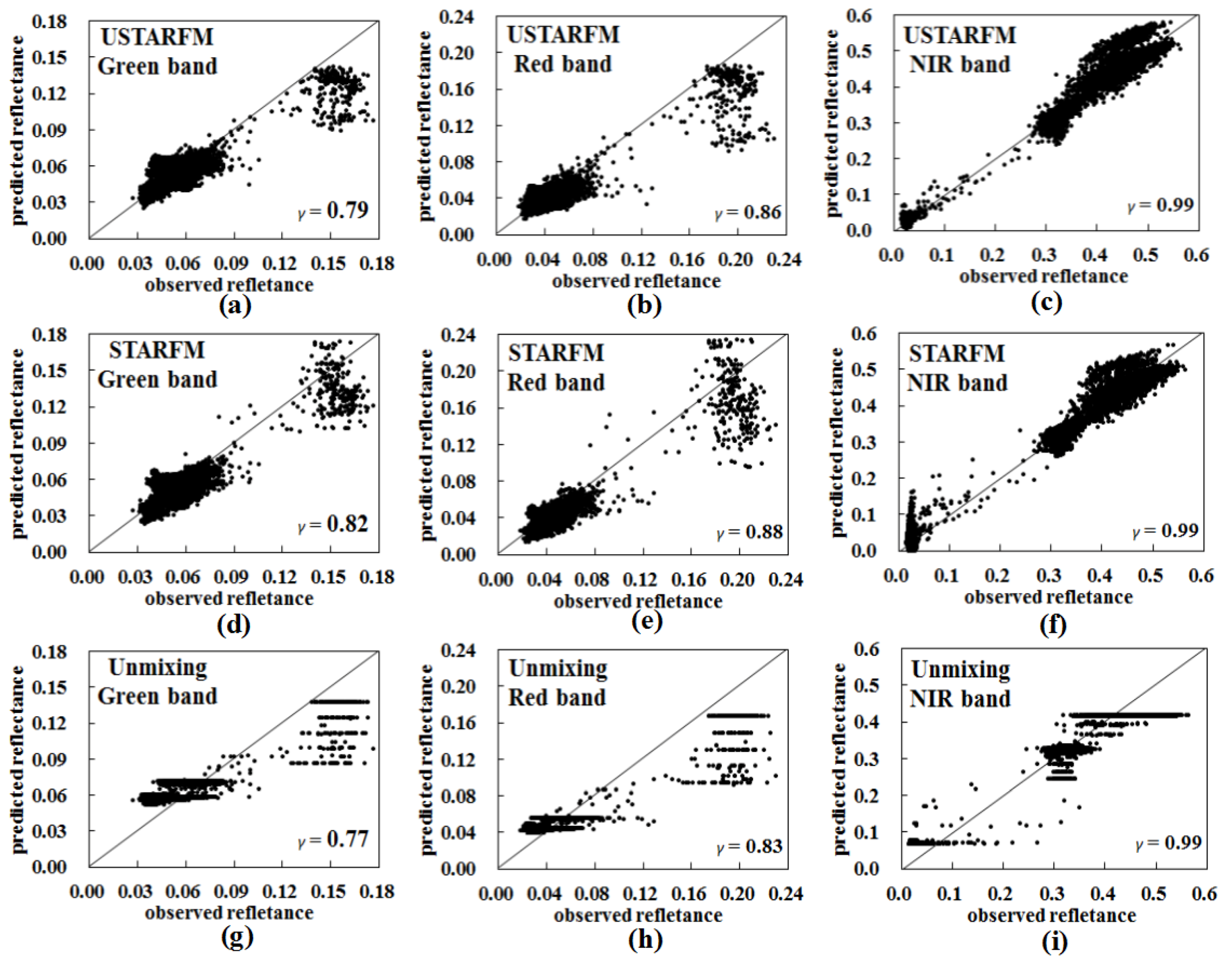
4.4. Synthetic Image Analysis

4.5. Algorithm Applicability Analysis
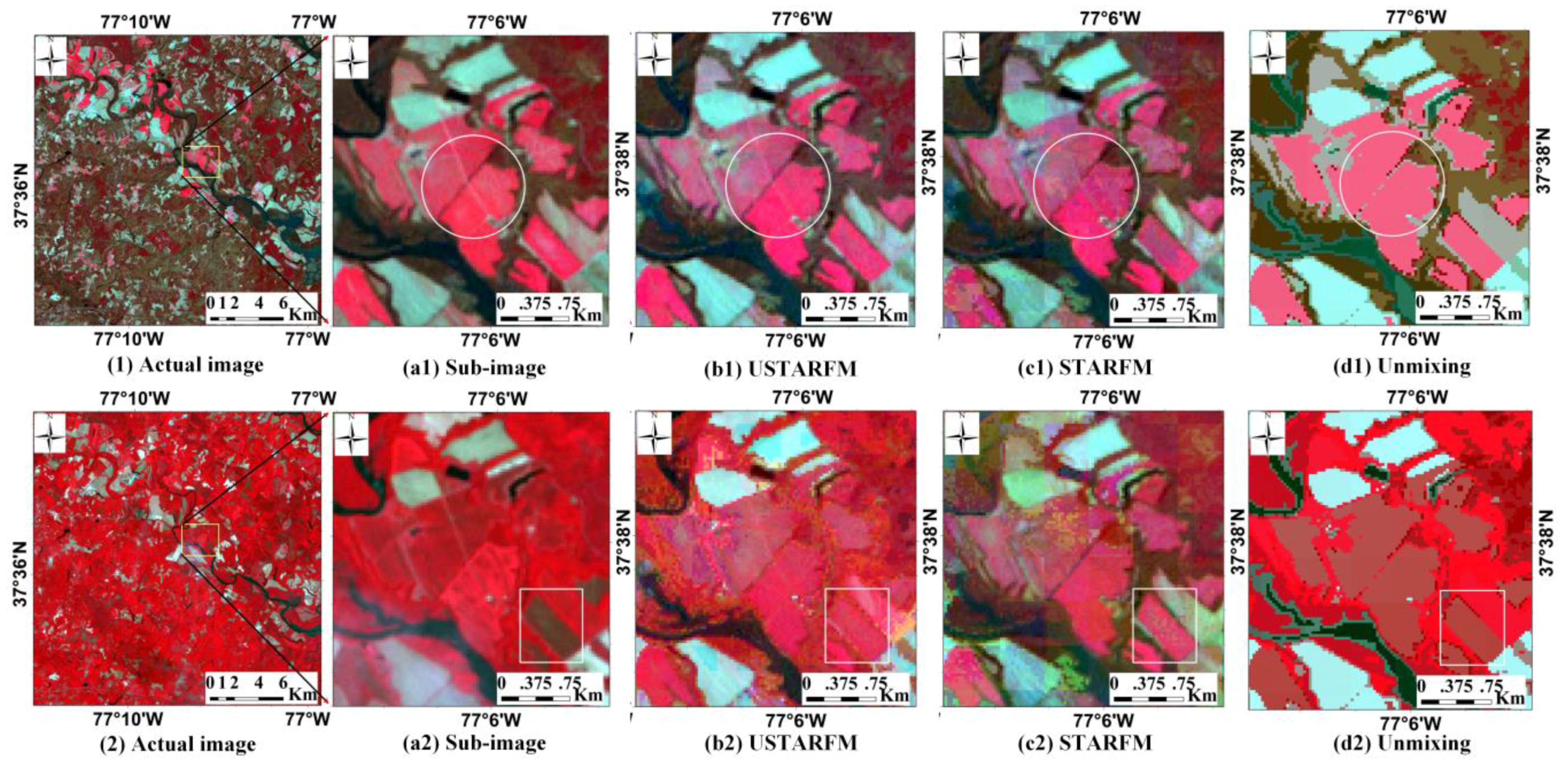
5. Conclusions
Acknowledgments
Author Contributions
Conflicts of Interest
References
- Zhang, W.; Li, A.; Jin, H.; Bian, J.; Zhang, Z.; Lei, G.; Qiu, Z.; Huang, C. An enhanced spatial and temporal data fusion model for fusing Landsat and MODIS surface reflectance to generate high temporal Landsat-like data. Remote Sens. 2013, 5, 5346–5368. [Google Scholar] [CrossRef]
- Price, J.C. How unique are spectral signatures? Remote Sens. Environ. 1994, 49, 181–186. [Google Scholar] [CrossRef]
- Emelyanova, I.V.; McVicar, T.R.; Van Niel, T.G.; Li, L.T.; van Dijk, A.I. Assessing the accuracy of blending Landsat-MODIS surface reflectance in two landscapes with contrasting spatial and temporal dynamics: A framework for algorithm selection. Remote Sens. Environ. 2013, 133, 193–209. [Google Scholar] [CrossRef]
- Rees, W.G.; Williams, M.; Vitebsky, P. Mapping land cover change in a reindeer herding area of the Russian arctic using Landsat TM and ETM+ imagery and indigenous knowledge. Remote Sens. Environ. 2003, 85, 441–452. [Google Scholar] [CrossRef]
- Masek, J.G.; Huang, C.; Wolfe, R.; Cohen, W.; Hall, F.; Kutler, J.; Nelson, P. North American forest disturbance mapped from a decadal Landsat record. Remote Sens. Environ. 2008, 112, 2914–2926. [Google Scholar] [CrossRef]
- Schroeder, T.A.; Wulder, M.A.; Healey, S.P.; Moisen, G.G. Mapping wildfire and clear-cut harvest disturbances in boreal forests with Landsat time series data. Remote Sens. Environ. 2011, 115, 1421–1433. [Google Scholar] [CrossRef]
- González-Sanpedro, M.C.; Le Toan, T.; Moreno, J.; Kergoat, L.; Rubio, E. Seasonal variations of leaf area index of agricultural fields retrieved from Landsat data. Remote Sens. Environ. 2008, 112, 810–824. [Google Scholar] [CrossRef]
- Ju, J.; Roy, D.P. The availability of cloud-free Landsat ETM+ data over the conterminous United States and globally. Remote Sens. Environ. 2008, 112, 1196–1211. [Google Scholar] [CrossRef]
- Arvor, D.; Jonathan, M.; Meirelles, M.S.P.; Dubreuil, V.; Durieux, L. Classification of MODIS EVI time series for crop mapping in the state of Mato Grosso, Brazil. Int. J. Remote Sens. 2011, 32, 7847–7871. [Google Scholar] [CrossRef]
- Notarnicola, C.; Duguay, M.; Moelg, N.; Schellenberger, T.; Tetzlaff, A.; Monsorno, R.; Costa, A.; Steurer, C.; Zebisch, M. Snow cover maps from MODIS images at 250 m resolution, Part 1: Algorithm description. Remote Sens. 2013, 5, 110–126. [Google Scholar] [CrossRef]
- Zhou, H.; Aizen, E.; Aizen, V. Deriving long term snow cover extent dataset from AVHRR and MODIS data: Central Asia study. Remote Sens. Environ. 2013, 136, 146–162. [Google Scholar] [CrossRef]
- Shabanov, N.V.; Wang, Y.; Buermann, W.; Dong, J.; Hoffman, S.; Smith, G.R.; Tian, Y.; Knyazikhin, Y.; Myneni, R.B. Effect of foliage spatial heterogeneity in the MODIS LAI and FPAR algorithm over broadleaf forests. Remote Sens. Environ. 2003, 85, 410–423. [Google Scholar] [CrossRef]
- Lunetta, R.S.; Lyon, J.G.; Guindon, B.; Elvidge, C.D. North American landscape characterization dataset development and data fusion issues. Photogramm. Eng. Remote Sens. 1998, 64, 821–828. [Google Scholar]
- Arai, E.; Shimabukuro, Y.E.; Pereira, G.; Vijaykumar, N.L. A multi-resolution multi-temporal technique for detecting and mapping deforestation in the Brazilian amazon rainforest. Remote Sens. 2011, 3, 1943–1956. [Google Scholar] [CrossRef]
- Bioucas-Dias, J.M.; Plaza, A.; Dobigeon, N.; Parente, M.; Du, Q.; Gader, P.; Chanussot, J. Hyperspectral unmixing overview: Geometrical, statistical, and sparse regression-based approaches. IEEE J. Appl. Earth Obs. Remote Sens. 2012, 5, 354–379. [Google Scholar] [CrossRef]
- Zhukov, B.; Oertel, D.; Lanzl, F.; Reinhackel, G. Unmixing-based multisensor multiresolution image fusion. IEEE Trans. Geosci. Remote Sens. 1999, 37, 1212–1226. [Google Scholar] [CrossRef]
- Keshava, N.; Mustard, J.F. Spectral unmixing. IEEE Signal Proc. Mag. 2002, 19, 44–57. [Google Scholar] [CrossRef]
- Zurita-Milla, R.; Clevers, J.G.P.W.; Schaepman, M.E. Unmixing-based Landsat TM and MERIS FR data fusion. IEEE Geosci. Remote Sens. Lett. 2008, 5, 453–457. [Google Scholar] [CrossRef]
- Zurita-Milla, R.; Kaiser, G.; Clevers, J.G.P.W.; Schneider, W.; Schaepman, M.E. Unmixing time series of MERIS full resolution data to monitor vegetation seasonal dynamics. Remote Sens. Environ. 2009, 113, 1874–1885. [Google Scholar] [CrossRef]
- Amorós-López, J.; Gómez-Chova, L.; Alonso, L.; Guanter, L.; Zurita-Milla, R.; Moreno, J.; Camps-Valls, G. Multitemporal fusion of Landsat/TM and ENVISAT/MERIS for crop monitoring. Int. J. Appl. Earth Obs. Geoinf. 2013, 23, 132–141. [Google Scholar] [CrossRef]
- Zurita-Milla, R.; Gómez-Chova, L.; Guanter, L.; Clevers, J.G.; Camps-Valls, G. Multitemporal unmixing of medium-spatial-resolution satellite images: A case study using MERIS images for land-cover mapping. IEEE Trans. Geosci. Remote Sens. 2011, 49, 4308–4317. [Google Scholar] [CrossRef]
- Gevaert, C.M.; García-Haro, F.J. A Comparison of STARFM and an Unmixing-based algorithm for Landsat and MODIS data fusion. Remote Sens. Environ. 2015, 156, 34–44. [Google Scholar] [CrossRef]
- Liu, D.; Pu, R. Downscaling thermal infrared radiance for subpixel land surface temperature retrieval. Sensors 2008, 8, 2695–2706. [Google Scholar] [CrossRef]
- Wu, M.Q.; Huang, W.J.; Niu, Z.; Wang, C.Y. Generating daily synthetic Landsat imagery by combining Landsat and MODIS data. Sensors 2015, 15, 24002–24025. [Google Scholar] [CrossRef] [PubMed]
- Gao, F.; Masek, J.; Schwaller, M.; Hall, F. On the blending of the Landsat and MODIS surface reflectance: Predicting daily Landsat surface reflectance. IEEE Trans. Geosci. Remote Sens. 2006, 44, 2207–2218. [Google Scholar]
- Xu, Y.; Huang, B.; Xu, Y.; Cao, K.; Guo, C.L.; Meng, D.Y. Spatial and Temporal Image Fusion via Regularized Spatial Unmixing. IEEE Geosci. Remote Sens. Lett. 2015, 12, 1362–1366. [Google Scholar]
- Wu, M.Q.; Li, H.; Huang, W.J.; Niu, Z.; Wang, C.Y. Generating daily high spatial land surface temperatures by combining ASTER and MODIS land surface temperature products for environmental process monitoring. Environ. Sci. Process. Impacts. 2015, 17, 1396–1404. [Google Scholar] [CrossRef] [PubMed]
- Hilker, T.; Wulder, M.A.; Coops, N.C.; Linke, J.; McDermid, G.; Masek, J.G.; Gao, F.; White, J.C. A new data fusion model for high spatial-and temporal-resolution mapping of forest disturbance based on Landsat and MODIS. Remote Sens. Environ. 2009, 113, 1613–1627. [Google Scholar] [CrossRef]
- Singh, D. Generation and evaluation of gross primary productivity using Landsat data through blending with MODIS data. Int. J. Appl. Earth Obs. Geoinf. 2011, 13, 59–69. [Google Scholar] [CrossRef]
- Zhu, X.; Chen, J.; Gao, F.; Chen, X.; Masek, J.G. An enhanced spatial and temporal adaptive reflectance fusion model for complex heterogeneous regions. Remote Sens. Environ. 2010, 114, 2610–2623. [Google Scholar] [CrossRef]
- Wu, M.; Niu, Z.; Wang, C.; Wu, C.; Wang, L. Use of MODIS and Landsat time series data to generate high-resolution temporal synthetic Landsat data using a spatial and temporal reflectance fusion Model. J. Appl. Remote Sens. 2012, 6. [Google Scholar] [CrossRef]
- Wu, C.; Chen, J.; Huang, N. Predicting gross primary production from the enhanced vegetation index and photosynthetically active radiation: Evaluation and calibration. Remote Sens. Environ. 2011, 115, 3424–3435. [Google Scholar] [CrossRef]
- Settle, J.J.; Drake, N.A. Linear mixing and the estimation of ground cover proportions. Int. J. Remote Sens. 1993, 14, 1159–1177. [Google Scholar] [CrossRef]
- García-Haro, F.J.; Sommer, S.; Kemper, T. A new tool for variable multiple endmember spectral mixture analysis (VMESMA). Int. J. Remote Sens. 2005, 26, 2135–2162. [Google Scholar] [CrossRef]
- Busetto, L.; Meroni, M.; Colombo, R. Combining medium and coarse spatial resolution satellite data to improve the estimation of sub-pixel NDVI time series. Remote Sens. Environ. 2008, 112, 118–131. [Google Scholar] [CrossRef]
- Jia, K.; Liang, S.; Zhang, N.; Wei, X.; Gu, X.; Zhao, X.; Yao, Y.; Xie, X. Land cover classification of finer resolution remote sensing data integrating temporal features from time series coarser resolution data. ISPRS J. Photogramm. Remote Sens. 2014, 93, 49–55. [Google Scholar] [CrossRef]
- Lillo-Saavedra, M.; Gonzalo, C.; Arquero, A.; Martinez, E. Fusion of multispectral and panchromatic satellite sensor imagery based on tailored filtering in the Fourier domain. Int. J. Remote Sens. 2005, 26, 1263–1268. [Google Scholar] [CrossRef]
- Vermote, E.F.; El Saleous, N.Z.; Justice, C.O. Atmospheric correction of MODIS data in the visible to middle infrared: First results. Remote Sens. Environ. 2002, 83, 97–111. [Google Scholar] [CrossRef]
- Amorós-López, J.; Gómez-Chova, L.; Alonso, L.; Guanter, L.; Moreno, J.; Camps-Valls, G. Regularized multiresolution spatial unmixing for ENVISAT/MERIS and Landsat/TM image fusion. IEEE Geosci. Remote Sens. Lett. 2011, 8, 844–848. [Google Scholar] [CrossRef]
- Tan, B.; Woodcock, C.E.; Hu, J.; Zhang, P.; Ozdogan, M.; Huang, D.; Myneni, R.B. The impact of gridding artifacts on the local spatial properties of MODIS data: Implications for validation, compositing, and band-to-band registration across resolutions. Remote Sens. Environ. 2006, 105, 98–114. [Google Scholar] [CrossRef]
© 2016 by the authors; licensee MDPI, Basel, Switzerland. This article is an open access article distributed under the terms and conditions of the Creative Commons by Attribution (CC-BY) license (http://creativecommons.org/licenses/by/4.0/).
Share and Cite
Xie, D.; Zhang, J.; Zhu, X.; Pan, Y.; Liu, H.; Yuan, Z.; Yun, Y. An Improved STARFM with Help of an Unmixing-Based Method to Generate High Spatial and Temporal Resolution Remote Sensing Data in Complex Heterogeneous Regions. Sensors 2016, 16, 207. https://doi.org/10.3390/s16020207
Xie D, Zhang J, Zhu X, Pan Y, Liu H, Yuan Z, Yun Y. An Improved STARFM with Help of an Unmixing-Based Method to Generate High Spatial and Temporal Resolution Remote Sensing Data in Complex Heterogeneous Regions. Sensors. 2016; 16(2):207. https://doi.org/10.3390/s16020207
Chicago/Turabian StyleXie, Dengfeng, Jinshui Zhang, Xiufang Zhu, Yaozhong Pan, Hongli Liu, Zhoumiqi Yuan, and Ya Yun. 2016. "An Improved STARFM with Help of an Unmixing-Based Method to Generate High Spatial and Temporal Resolution Remote Sensing Data in Complex Heterogeneous Regions" Sensors 16, no. 2: 207. https://doi.org/10.3390/s16020207
APA StyleXie, D., Zhang, J., Zhu, X., Pan, Y., Liu, H., Yuan, Z., & Yun, Y. (2016). An Improved STARFM with Help of an Unmixing-Based Method to Generate High Spatial and Temporal Resolution Remote Sensing Data in Complex Heterogeneous Regions. Sensors, 16(2), 207. https://doi.org/10.3390/s16020207






